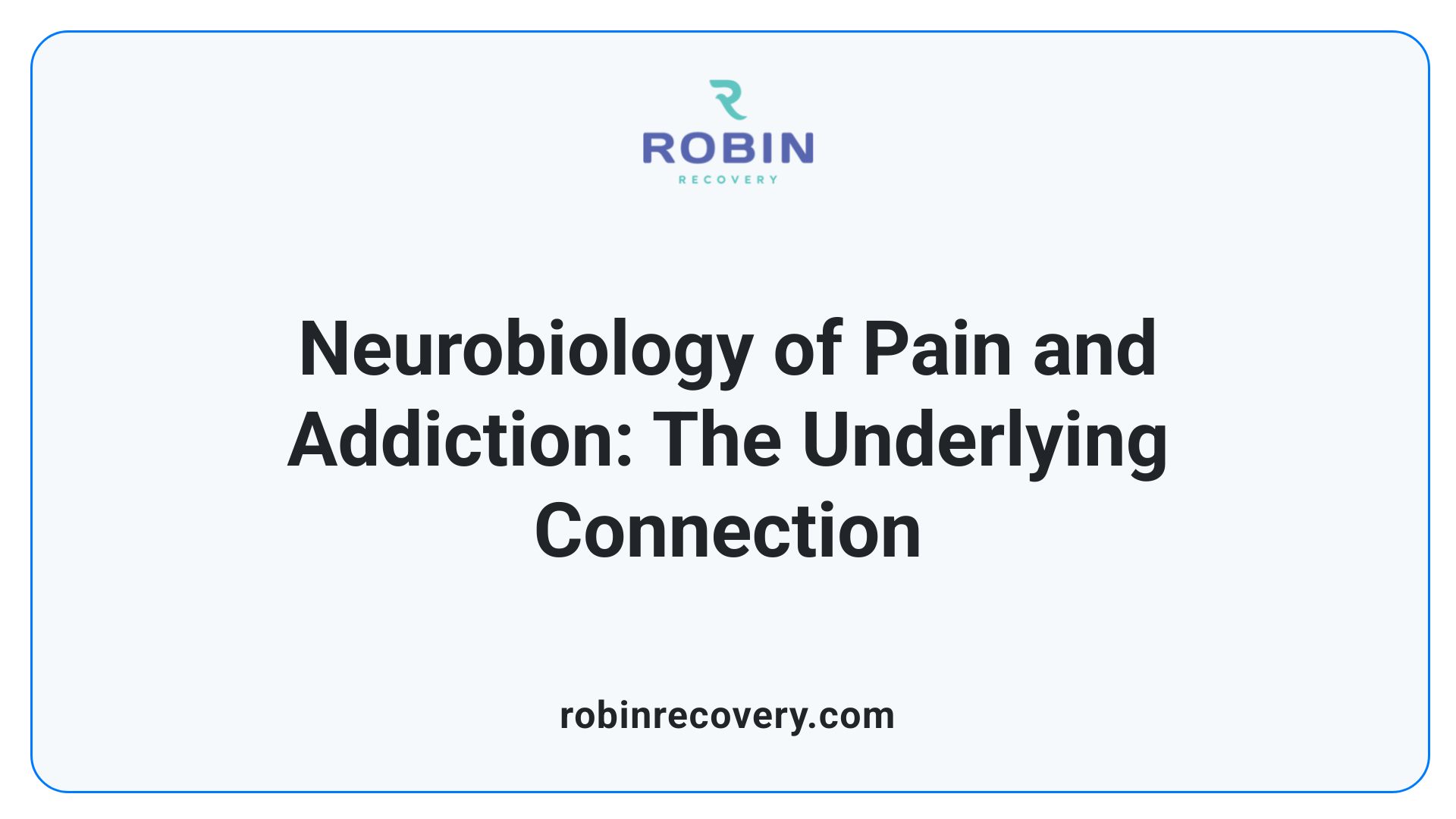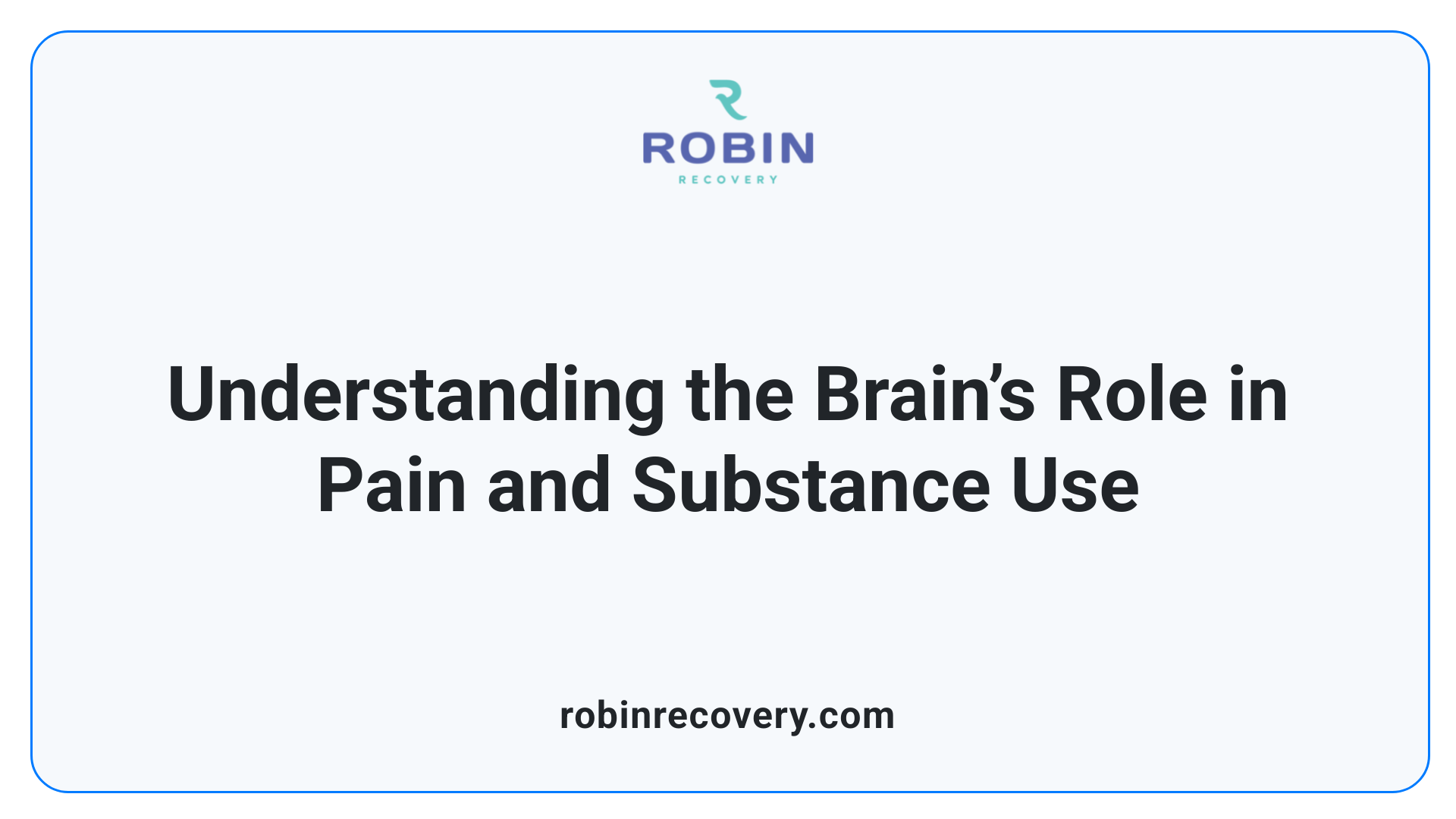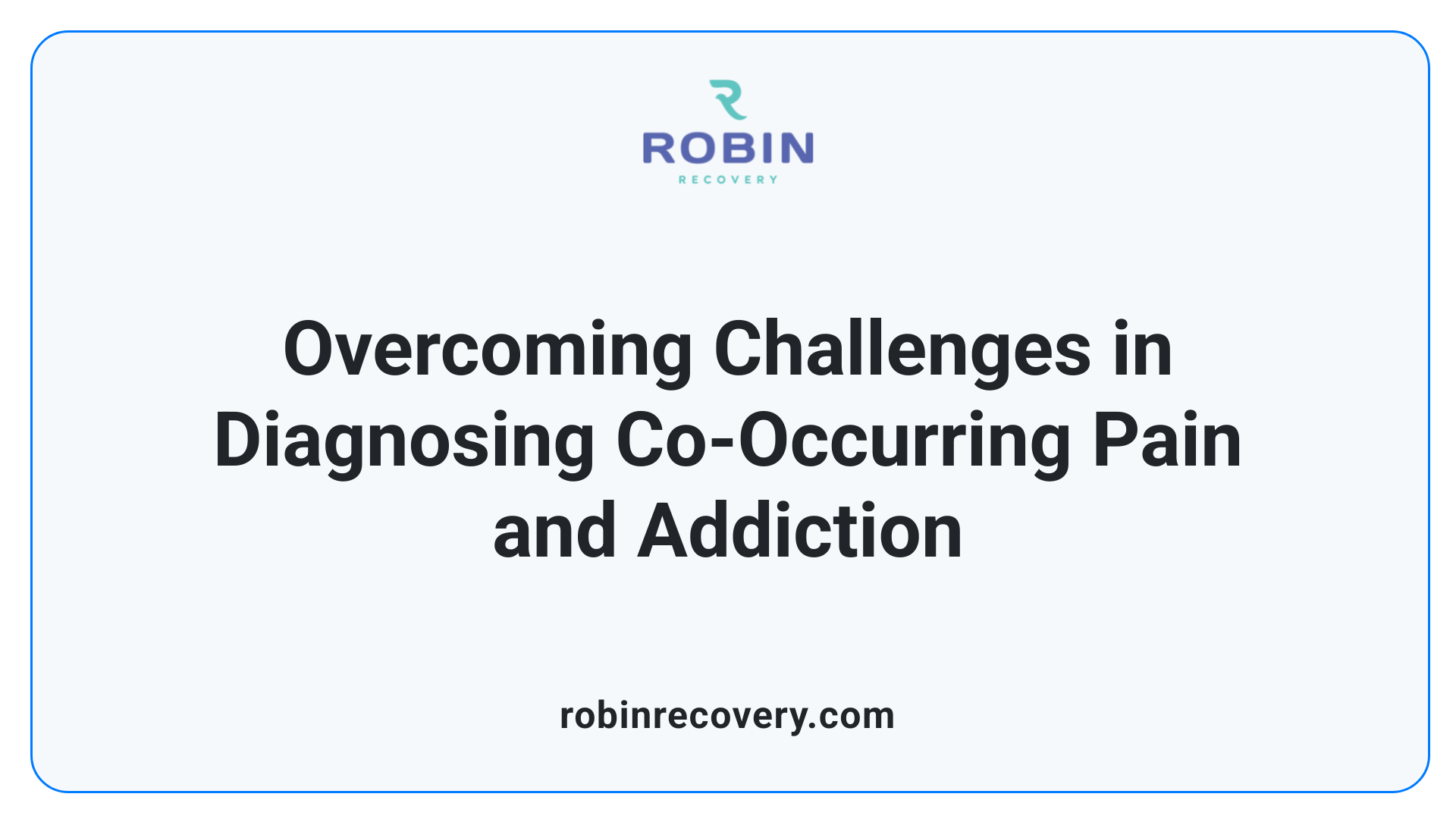The Connection Between Addiction and Chronic Pain

Understanding the Interplay Between Chronic Pain and Substance Use Disorders
Chronic pain affects millions and often coexists with substance use disorders, creating a complex clinical challenge. While opioids are widely used for pain management, their potential to foster addiction complicates treatment strategies. This article explores the neurobiological, psychological, and physiological pathways connecting addiction and chronic pain, emphasizing the importance of integrated management approaches.
Biological Foundations of Chronic Pain and Addiction

What is chronic pain linked to?
Chronic pain is associated with diverse causes, including injuries, illnesses, and sometimes no identifiable origin. Conditions such as fibromyalgia, arthritis, nerve damage, diabetes, and cancer can all lead to persistent pain. It often develops after injury or surgery, lasting longer than the typical healing period—usually over 12 weeks—and its intensity can range from mild to debilitating.
This type of pain is characterized by sensations like burning, stabbing, aching, or electrical shocks. Psychological factors such as depression, anxiety, and stress can worsen the experience of chronic pain, creating a complex interplay between mental health and physical symptoms. Moreover, changes in brain chemicals regulating pain, along with neural processing dysfunction, contribute to symptoms even when no clear physical cause is evident.
Because of this complex neurobiological and psychological landscape, comprehensive treatment strategies are essential. Addressing only physical pain without considering emotional and cognitive components often results in suboptimal outcomes. This underscores the importance of multidisciplinary approaches that include medication, behavioral therapy, and lifestyle modifications to manage chronic pain effectively.
What is the connection between chronic pain and addiction?
Chronic pain and addiction often coexist due to their shared neurobiological pathways, especially when opioids are used for pain relief. Opioids increase dopamine levels in brain reward systems, producing euphoria and relief from pain. However, this activation can lead to tolerance—requiring higher doses—and dependence, where the body adapts to the drug’s presence.
This relationship creates a cycle where patients may escalate medication use to control pain or emotional distress, inadvertently reinforcing addictive behaviors. Over time, dependence can evolve into a substance use disorder, with risks of misuse, overdose, or transitioning to illegal drugs like heroin. Studies indicate that many individuals who abuse heroin initially misused prescription opioids, highlighting the strong link between chronic pain management and SUD.
Effective management involves careful prescribing, patient monitoring, and employing alternative therapies to minimize dependence risk while controlling pain.
How does opioid use influence the relationship between pain management and addiction?
Opioid medications are potent pain relievers but pose significant risks related to addiction. When used long-term, opioids can enhance neuroplastic changes—neuroadaptations—that heighten pain sensitivity (hyperalgesia) and facilitate addiction.
Prolonged opioid use impacts brain circuits involved in reward, motivation, and stress—the same pathways implicated in addiction. This neurobiological overlap means that persistent pain can sensitize the brain to drug effects, fostering cravings and misuse.
Clinicians aim to balance pain relief with minimizing addiction risk by adopting multimodal treatments, such as combining non-opioid medications, physical therapy, and psychological support. Close patient monitoring, including regular screening for misuse, is essential to prevent escalation of use and support recovery.
What strategies are effective in managing pain among patients with addiction concerns?
Managing pain in patients with a history or risk of addiction requires tailored, cautious approaches. Non-opioid medications like NSAIDs and anticonvulsants (pregabalin, gabapentin), antidepressants, and topical treatments can be effective.
Integrating nonpharmacologic therapies—such as physical therapy, acupuncture, massage, mindfulness, and cognitive-behavioral therapy—helps address both physical and emotional aspects of pain. Establishing clear treatment plans, with agreements on medication use, regular urine drug testing, and involving specialists in addiction can reduce misuse.
Interventional procedures like nerve blocks or spinal cord stimulation are useful for refractory cases. Ensuring open communication and patient education about risks and expectations further supports safe pain management.
Are addicts more sensitive to pain?
Research indicates that individuals with substance use disorders, especially those involving opioids or alcohol, may experience enhanced pain sensitivity, a phenomenon known as hyperalgesia. Excessive or prolonged use of substances can cause neuroadaptive changes in the nervous system, increasing the perception and emotional impact of pain.
This heightened sensitivity complicates pain management, often requiring higher or more complex treatment regimens. It also underscores the importance of addressing substance use and providing comprehensive, multidisciplinary care to improve outcomes.
How does opioid use influence the relationship between pain management and addiction?
(Repeated for emphasis) - Opioid use profoundly affects the dynamics of pain treatment by increasing the risk of dependence and addiction, especially with ongoing use. Although beneficial short-term, long-term opioid therapy can lead to tolerance, hyperalgesia, and brain changes that reinforce compulsive use.
Understanding this interconnectedness prompts healthcare providers to adopt cautious prescribing, favor non-addictive options, and implement close monitoring to prevent problematic use while ensuring adequate pain control.
What are alternative treatments to opioids for managing chronic pain?
Alternatives to opioids include a variety of pharmacologic and nonpharmacologic options. Non-addictive medications like NSAIDs, anticonvulsants, antidepressants, and topical agents provide pain relief with fewer risks.
Complementary therapies such as physical therapy, acupuncture, chiropractic work, massage, meditation, and yoga have demonstrated efficacy in reducing pain and improving mental health. Psychological interventions like cognitive-behavioral therapy help modify pain perceptions and develop coping strategies.
These combined approaches form evidence-based, multidisciplinary pain management plans aimed at minimizing opioid reliance while optimizing patient well-being.
What is central sensitization and its relevance in opioid use disorder?
Central sensitization describes abnormal neural processing where the spinal cord and brain become overly responsive to pain signals. This process amplifies pain perception and hampers the brain’s ability to dampen ongoing pain.
Research shows that individuals with opioid use disorder often exhibit higher levels of central sensitization, associated with poorer quality of life and increased pain. This neuroadaptive state complicates treatment, as it sustains pain even when its cause is treated, and can perpetuate opioid misuse.
Recognizing and targeting central sensitization through therapies like neuroimmune modulation or specific medications can potentially improve pain management and reduce dependency risks, emphasizing the need for comprehensive neurobiological interventions.
Physiological and Psychological Factors Linking Pain and Addiction

How does chronic stress influence both pain and addiction?
Chronic stress plays a significant role in the development and persistence of both pain and addiction. It impairs the functioning and structural integrity of the ventromedial prefrontal cortex (VmPFC), a crucial brain region responsible for regulating stress, emotion, and pain. When the VmPFC is compromised, individuals become more vulnerable to experiencing chronic pain and developing emotional disorders such as depression and anxiety.
The overlapping neural circuits involve key areas like the amygdala, hippocampus, insula, and dorsal anterior cingulate cortex. These structures work together to process pain, stress, and emotional responses. Chronic stress can cause these circuits to become dysregulated, creating a feedback loop that exacerbates pain symptoms and promotes substance misuse as a maladaptive coping mechanism.
This neurobiological overlap makes managing both conditions complex. Strategies that reduce psychological stress, such as mindfulness-based techniques and cognitive behavioral therapy (CBT), can help restore balance in these circuits. By strengthening self-regulation, these approaches may decrease vulnerability to both chronic pain and addiction.
What psychological factors are associated with the co-occurrence of pain and addiction?
Psychological components such as depression, anxiety, catastrophizing thoughts, and emotional distress are commonly linked to both chronic pain and substance misuse. These factors can intensify pain perception and hinder effective coping, increasing the likelihood of turning to drugs—including opioids—for relief.
For instance, individuals experiencing high levels of catastrophizing may perceive pain as more severe and uncontrollable, prompting them to seek immediate relief through substances. Similarly, emotional distress can lead to self-medicating behaviors that escalate into dependence. The presence of these psychological issues often sustains a vicious cycle where pain worsens mental health, and mental health struggles deepen pain symptoms.
Addressing these factors through psychological interventions—like CBT, mindfulness, and counseling—is vital. These therapies can improve pain management, boost emotional resilience, and reduce the reliance on substances, thus disrupting the cycle of pain and addiction.
Can neurobiological strategies aid in managing both pain and addiction?
Emerging neurobiological treatments show promise for tackling both chronic pain and addiction simultaneously. These strategies target dysfunctional brain systems, such as reward pathways, neuroimmune responses, and anti-reward circuits.
For example, kappa opioid receptor antagonists are being investigated for their ability to block stress-induced dysphoria and reduce pain sensitivity. Neuroimmune modulators aim to control inflammation and neuroinflammation that contribute to chronic pain and addictive behaviors.
Additionally, approaches focusing on neural plasticity—like cognitive-behavioral therapy, mindfulness, and other mind-body interventions—seek to recalibrate brain circuits involved in reward and stress regulation. These therapies can promote a return to normal brain function, alleviating pain and reducing the craving or relapse potential.
Research into these neurobiological strategies reflects a growing understanding that effective treatment of chronic pain and addiction requires addressing their shared neuroadaptive mechanisms. By doing so, clinicians hope to develop more comprehensive, personalized interventions that break the cycle of pain and dependence.
Implications for Diagnosis and Treatment Strategies

What are the challenges in diagnosing co-occurring chronic pain and addiction?
Diagnosing both chronic pain and addiction at the same time presents significant challenges. This difficulty arises because the symptoms often overlap, such as ongoing discomfort, sleep disturbances, and emotional distress. Moreover, both conditions involve shared neurobiological pathways like alterations in brain reward circuits and stress response systems.
A key complication is differentiating between physical dependence, which can develop legitimately when medications like opioids are used as prescribed, and true addiction, characterized by compulsive drug-seeking behavior and psychological craving.
Patients with both issues may show nuanced clinical features, making it necessary for clinicians to conduct thorough evaluations. Utilizing a combination of standardized screening tools, detailed patient histories, and ongoing monitoring helps clarify the diagnoses. Multidisciplinary collaboration is crucial, as it allows for comprehensive assessments that encompass medical, psychological, and social factors.
Overall, accurate diagnosis requires careful consideration of the patient's substance use history, mental health status, and pain severity, emphasizing the importance of a holistic, patient-centered approach.
Why are multidisciplinary approaches vital in managing the connection between pain and addiction?
Managing the intertwined conditions of chronic pain and addiction demands a multifaceted strategy because both involve complex biological, psychological, and social elements. A multidisciplinary approach combines medical treatments—such as medications, physical therapy, or alternative therapies—with psychological support, including cognitive behavioral therapy (CBT), mindfulness, and counseling.
Social support systems, lifestyle interventions, and patient education form essential components of this model. Integrating these diverse elements ensures that treatment addresses not only physical symptoms but also emotional and behavioral health aspects.
For example, combining non-addictive pain management options like NSAIDs or anticonvulsants with psychological therapies helps reduce dependence on opioids, alleviates mental health issues like anxiety or depression, and improves overall functioning.
Collaboration among healthcare providers—including physicians, psychologists, physiotherapists, and addiction specialists—fosters tailored treatment plans. This teamwork reduces the risk of medication misuse, supports sobriety, and enhances quality of life for patients.
How can healthcare providers monitor and manage the risks of medication misuse?
To prevent medication misuse, healthcare providers can implement structured and sustainable risk management strategies. These include performing comprehensive risk assessments before initiating therapy, evaluating patient history for previous substance use issues, and assessing potential vulnerabilities.
Routine measures such as regular urine drug testing can help confirm adherence and detect unapproved drug use. Establishing clear treatment agreements and short-term prescribing protocols—particularly for opioids—are effective in limiting overuse.
Patient education plays a vital role; informing individuals about medication risks, proper use, and warning signs of misuse empowers them to participate actively in their own care. Transitioning patients to non-opioid therapies, like NSAIDs, anticonvulsants, or physical therapy, helps reduce dependence risk.
Involving addiction specialists when necessary and utilizing prescription monitoring programs allows for early identification of misuse or diversion. Maintaining open communication lines fosters trust, making patients comfortable to discuss concerns and adhere to safe practices.
Altogether, these strategies underscore the importance of personalized care plans that prioritize safety, reduce misuse potential, and optimize pain relief.
Aspect Strategies Notes Diagnosis Challenges Use of screening tools, multidisciplinary assessments Differentiating dependence from addiction Treatment Approaches Medical, psychological, social therapies Integrate non-addictive pain management Misuse Prevention Risk assessments, urine tests, agreements Monitor ongoing medication use and compliance Healthcare Team Physicians, psychologists, addiction specialists Collaborative, patient-centered care
This integrated approach aims to improve health outcomes, reduce risks associated with medications, and provide sustainable pain management solutions.
Innovative and Holistic Approaches for Pain and Addiction Management

What are some alternative, non-addictive treatments for chronic pain?
Managing chronic pain effectively while minimizing dependence risks has led to increasing interest in non-addictive therapies. Patients can turn to various medications that carry less addictive potential, such as NSAIDs (like ibuprofen or acetaminophen), anticonvulsants (pregabalin, gabapentin), and antidepressants. These medications target different pain pathways and can be quite effective.
In addition to medications, nonpharmacologic therapies play a vital role. Physical therapy, acupuncture, chiropractic adjustments, and therapeutic massage help alleviate pain through physical means, often improving flexibility and reducing muscle tension.
Mindfulness practices, meditation, yoga, and relaxation techniques contribute significantly to pain management by reducing stress and altering pain perception. Psychological interventions like cognitive-behavioral therapy (CBT) help patients develop coping strategies, challenge negative thoughts about pain, and foster resilience.
This holistic approach promotes a patient-centered model that balances pain control with safety, focusing on improving overall well-being while reducing the risk for dependency.
What innovative approaches show promise in treating both pain and addiction?
Recent advancements in understanding the neurobiology of pain and addiction have spurred the development of promising therapies. Neuroimmune modulators and kappa opioid receptor antagonists are emerging as potential treatments that can address the common neurocircuitry involved in both conditions.
These therapies aim to reset dysfunctional reward and stress systems, thereby reducing neuroinflammation, restoring healthy reward function, and attenuating pain signals. Neuroplasticity-based interventions like specialized cognitive-behavioral therapy and mindfulness training are also gaining attention for their ability to reshape neural circuits associated with pain and addictive behaviors.
By targeting the root neurobiological mechanisms, these approaches hold the potential for more effective, integrated management strategies that simultaneously address pain and substance use disorders.
How do holistic and lifestyle interventions contribute to pain management?
Holistic and lifestyle modifications are integral elements in managing chronic pain, especially when considering the interplay between physical, emotional, and psychological health. Practices such as meditation, herbal remedies, improved sleep hygiene, exercise, and counseling foster overall health and resilience.
Regular physical activity can strengthen muscles, improve flexibility, and promote endorphin release, which naturally alleviates pain. Yoga and guided relaxation techniques can help lower stress levels and improve emotional well-being.
Counseling and psychological support address mental health issues like depression and anxiety that often accompany chronic pain. These interventions support emotional regulation and reinforce positive behaviors, reducing the reliance on invasive treatments or medications.
Together, these strategies create a comprehensive care model that emphasizes self-management, resilience, and the interconnectedness of mind and body, leading to a more sustainable and less dependency-prone approach to pain relief.
Approach Main Focus Additional Benefits NSAIDs & anticonvulsants Pharmacological pain control Less addictive, target specific pain pathways Physical therapy & acupuncture Physical modality Improve flexibility, reduce muscle tension Mindfulness & CBT Psychological technique Alleviate stress, modify pain perception Lifestyle modifications Overall well-being Enhance resilience, improve mental and physical health Emerging treatments (kappa antagonists, neuroimmune modulators) Neurobiological Potential to treat both pain and addiction
Towards Comprehensive Care and Better Outcomes
The intricate relationship between chronic pain and addiction underscores the necessity for a multifaceted treatment paradigm. Understanding the neurobiological, physiological, and psychological pathways that overlap in these conditions can help tailor interventions that are both effective and safe. Moving away from a reliance solely on opioids towards integrated programs that include nonpharmacologic therapies, psychological support, and lifestyle modifications enhances the potential for recovery and improved quality of life. Continued research into neurobiological mechanisms and personalized treatment approaches holds promise for addressing this complex health challenge, ultimately leading to more effective, compassionate, and holistic patient care.
References
- How Chronic Pain Can Lead To Addiction Issues | Henry Ford Health
- Patients' perceptions of the pathways linking chronic pain with ...
- Chronic Pain And Addiction
- Study provides first evidence of link between opioid use disorder ...
- Common Brain Mechanisms of Chronic Pain and Addiction
- Chronic pain, chronic stress and substance use - Frontiers
- Drug dependence in patients with chronic pain - LWW - Medicine
